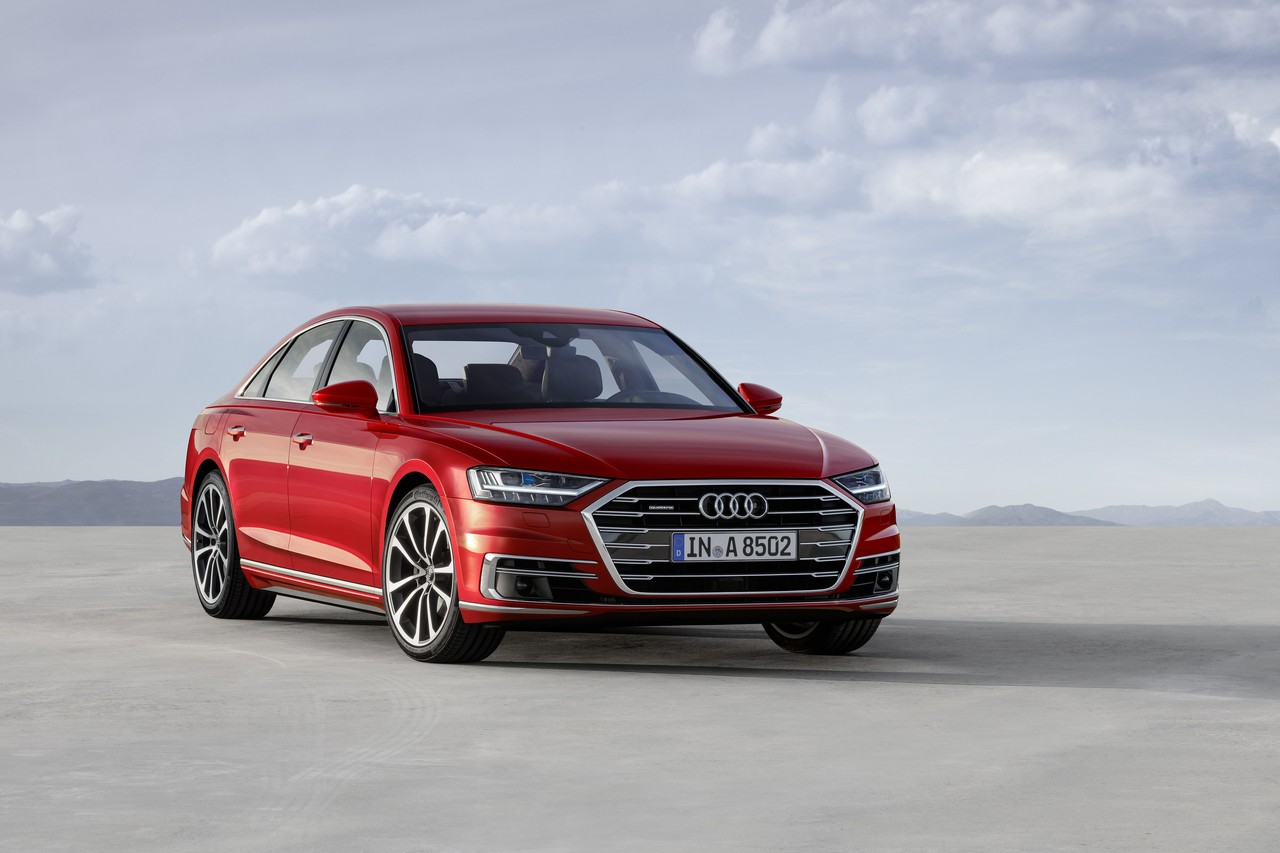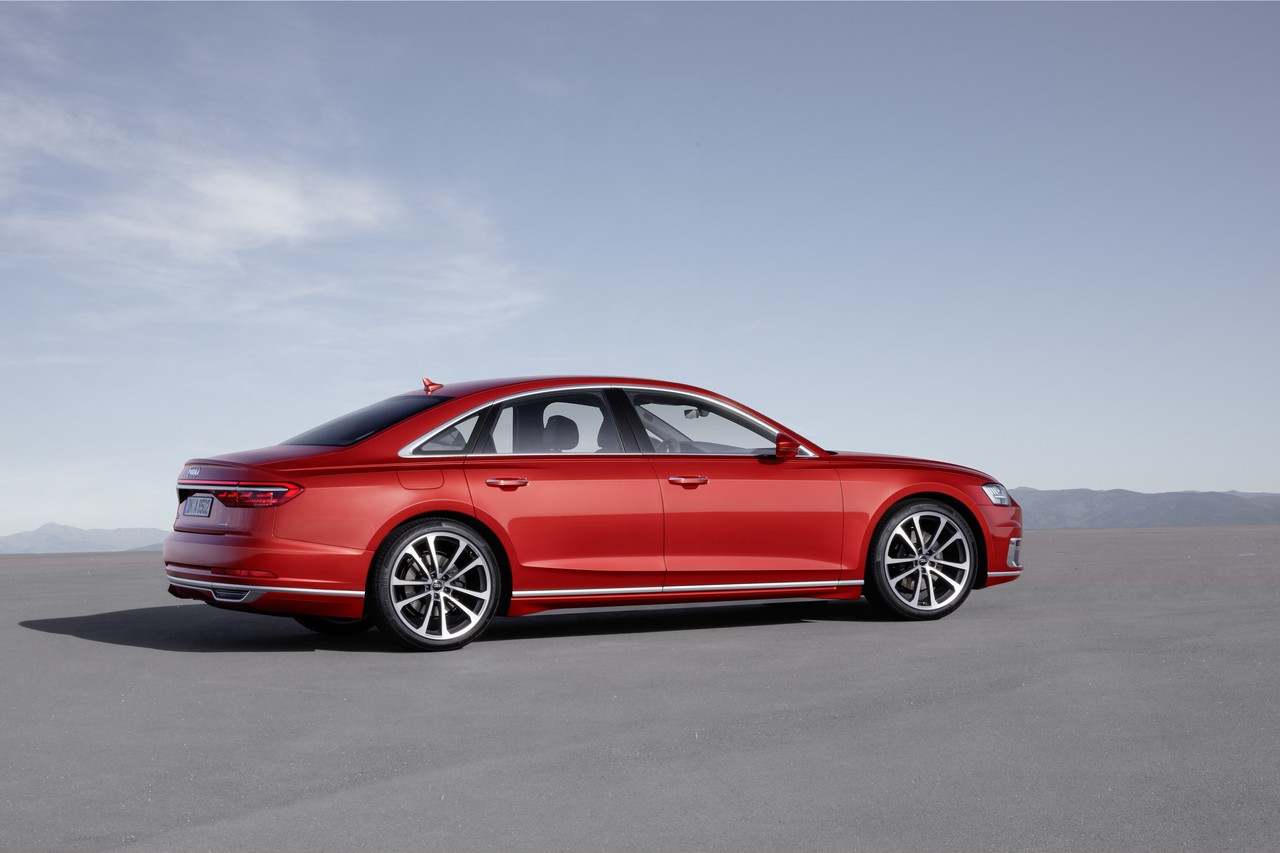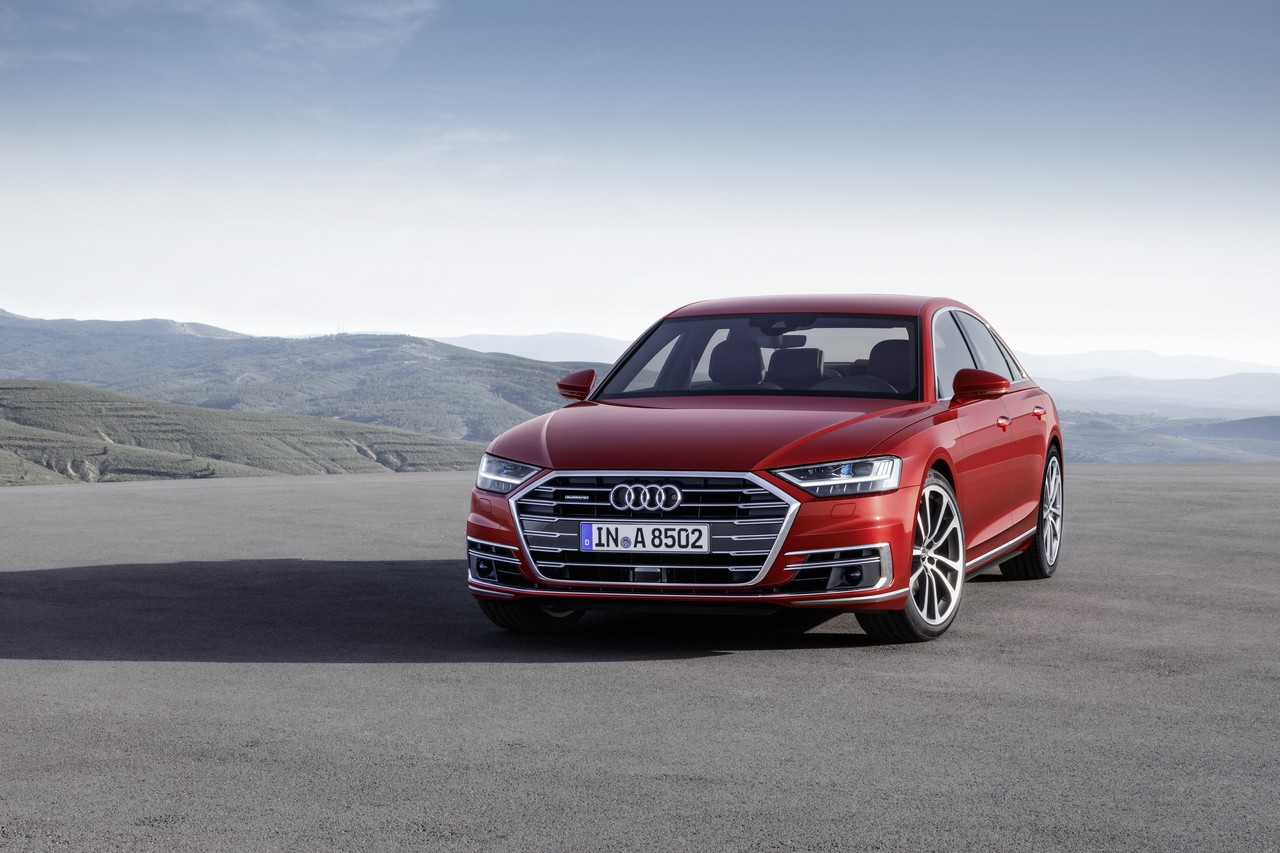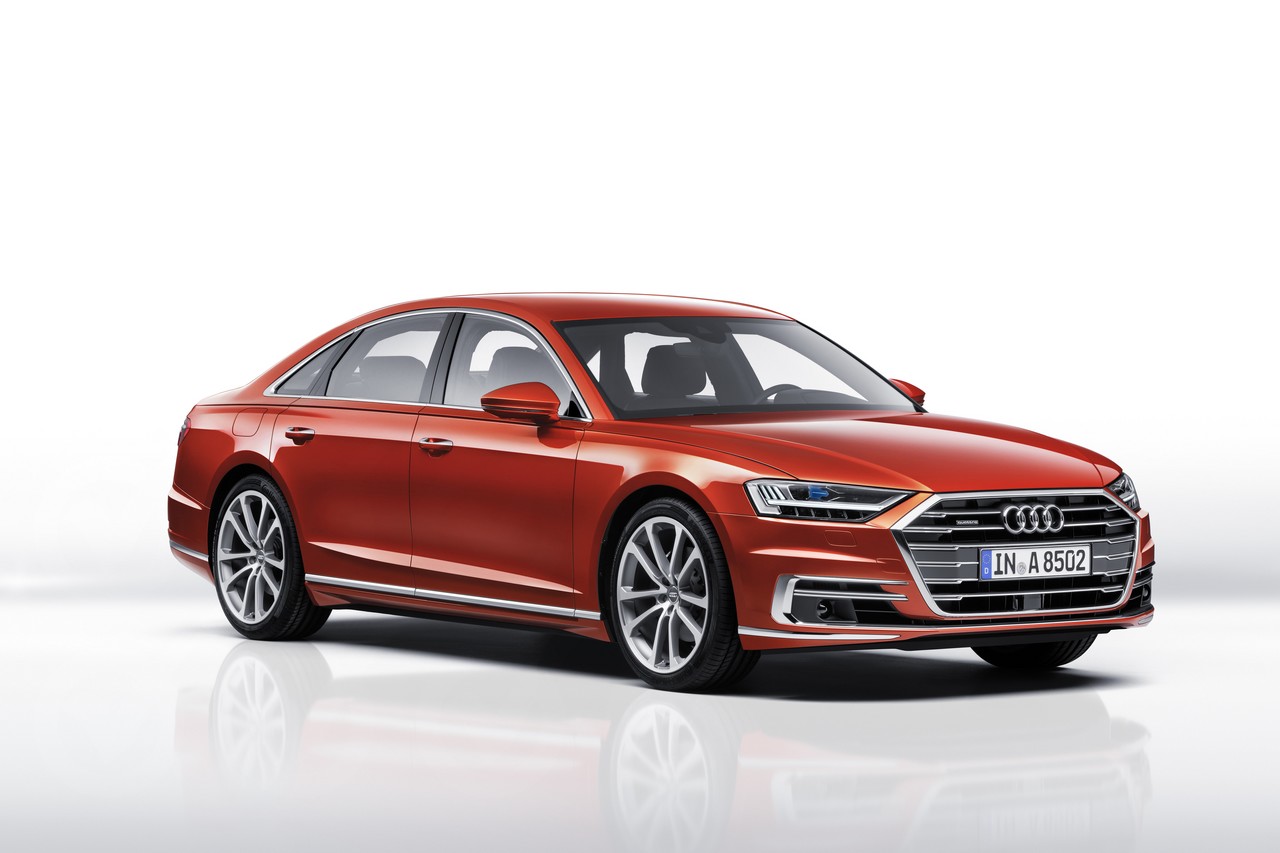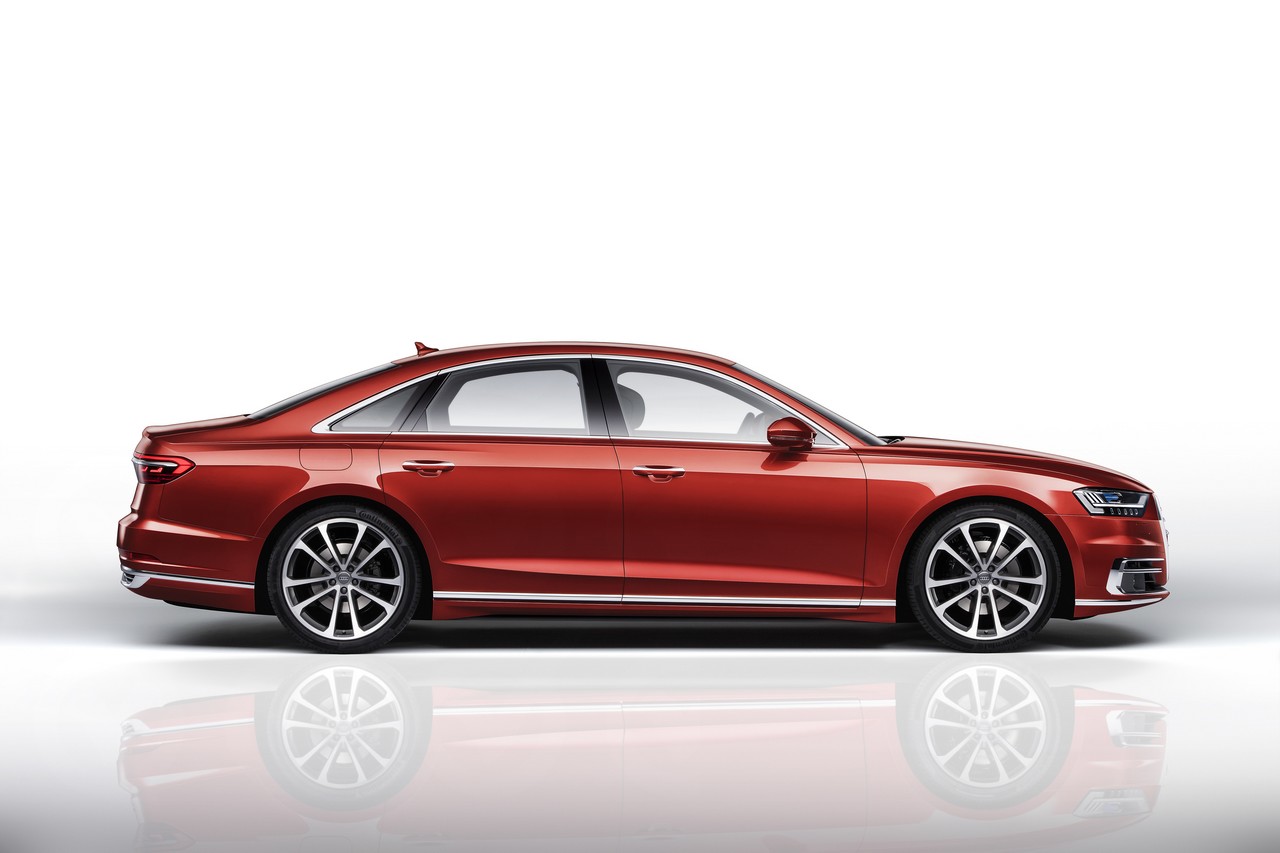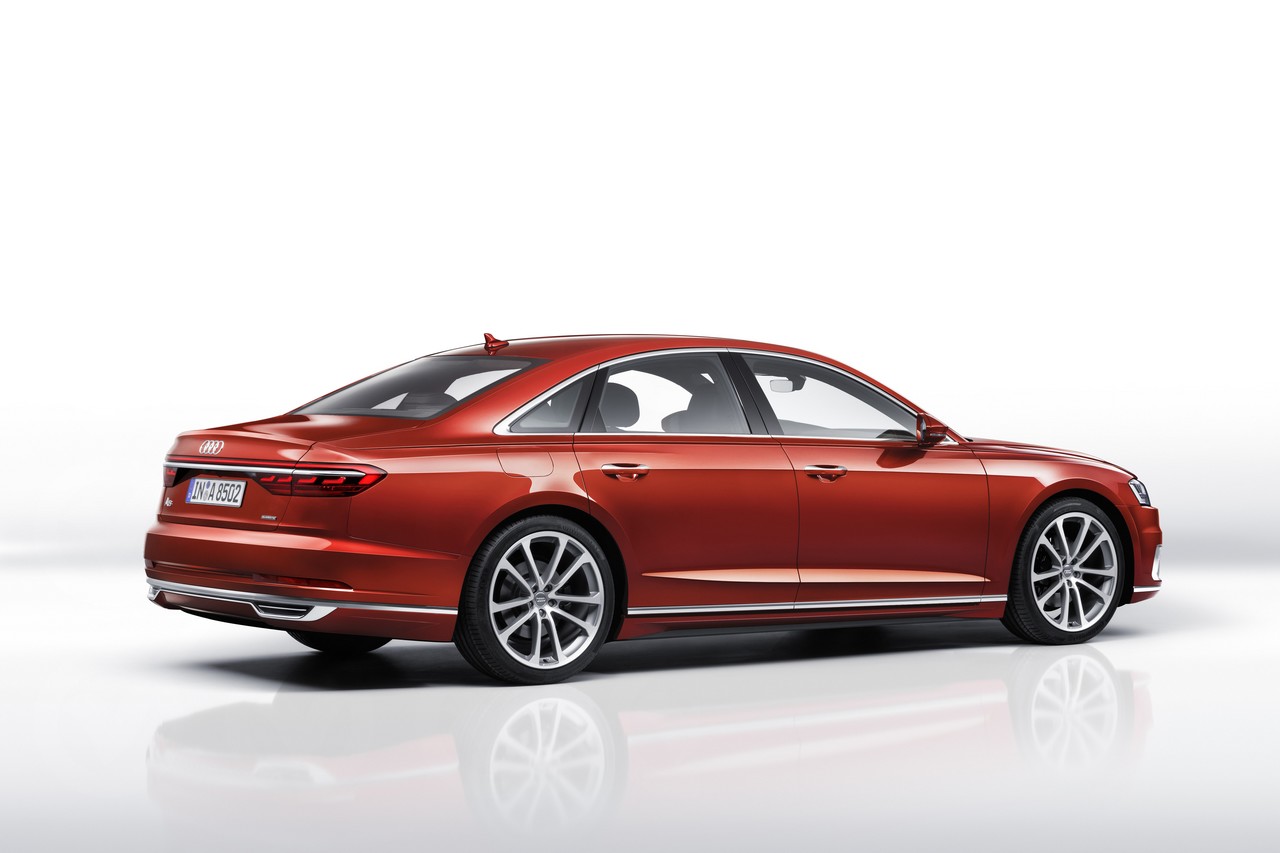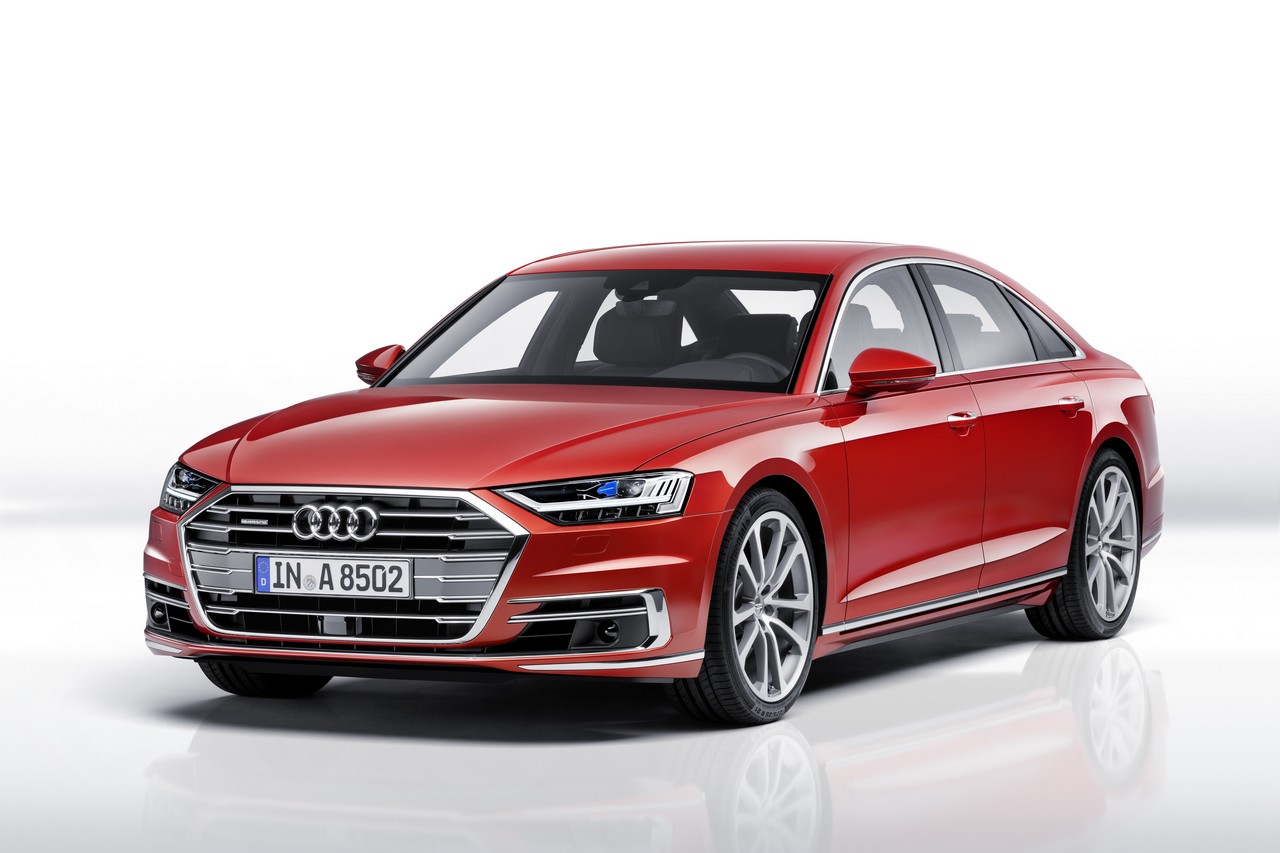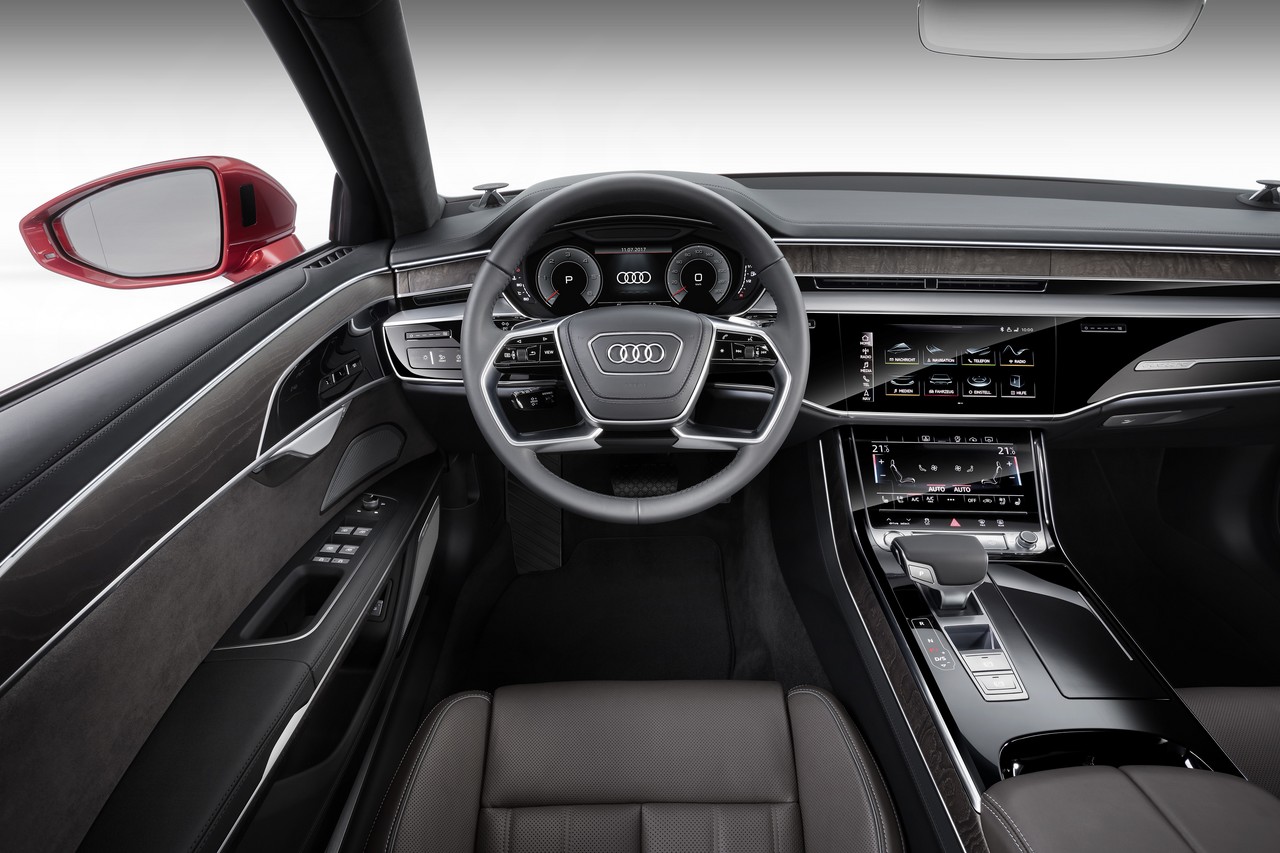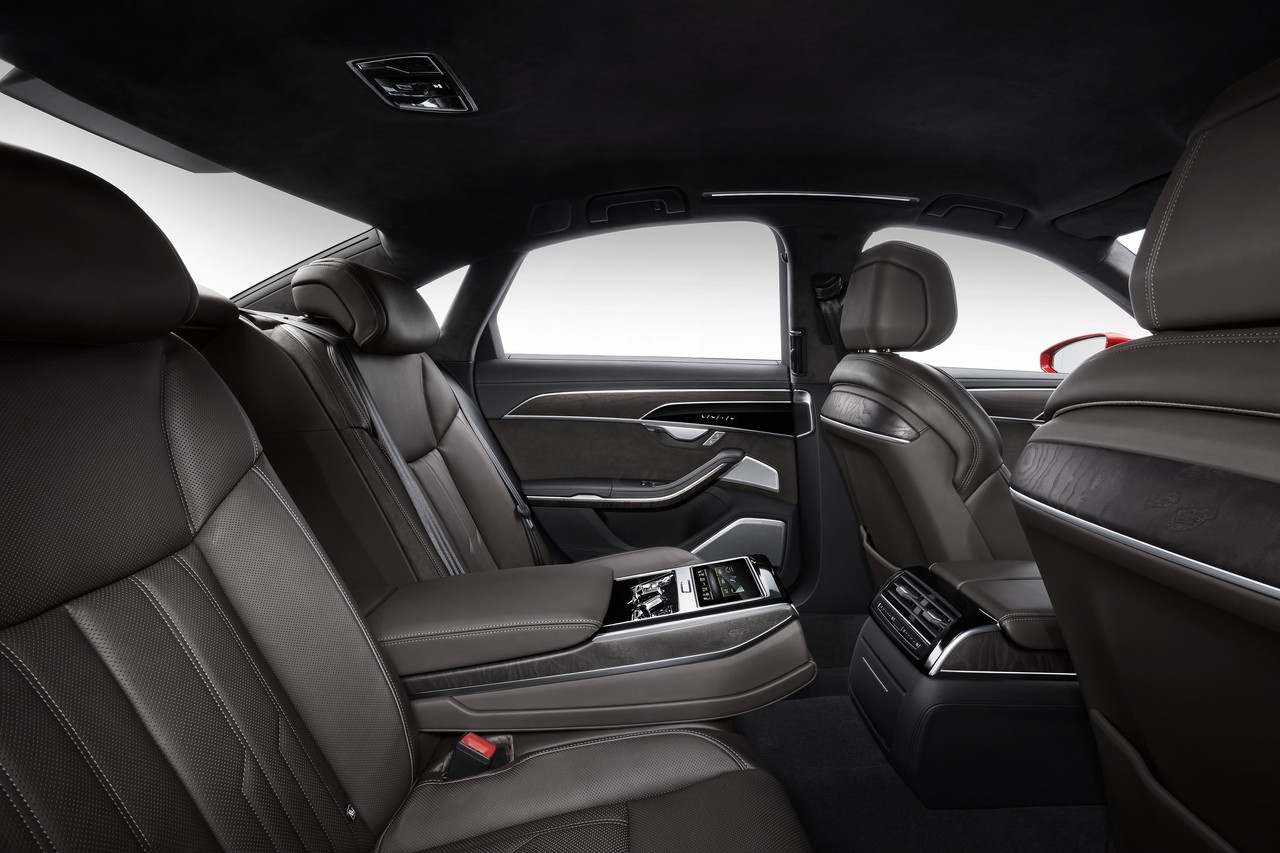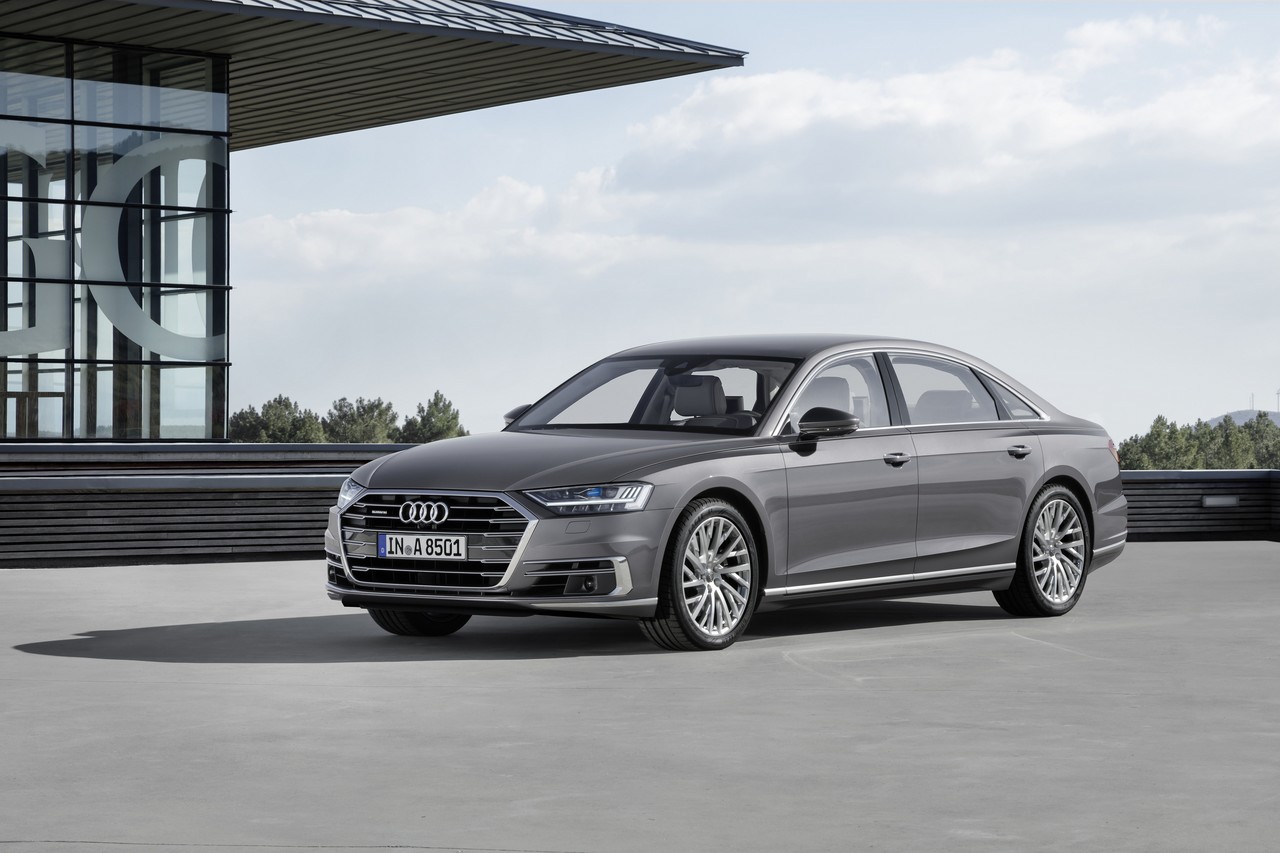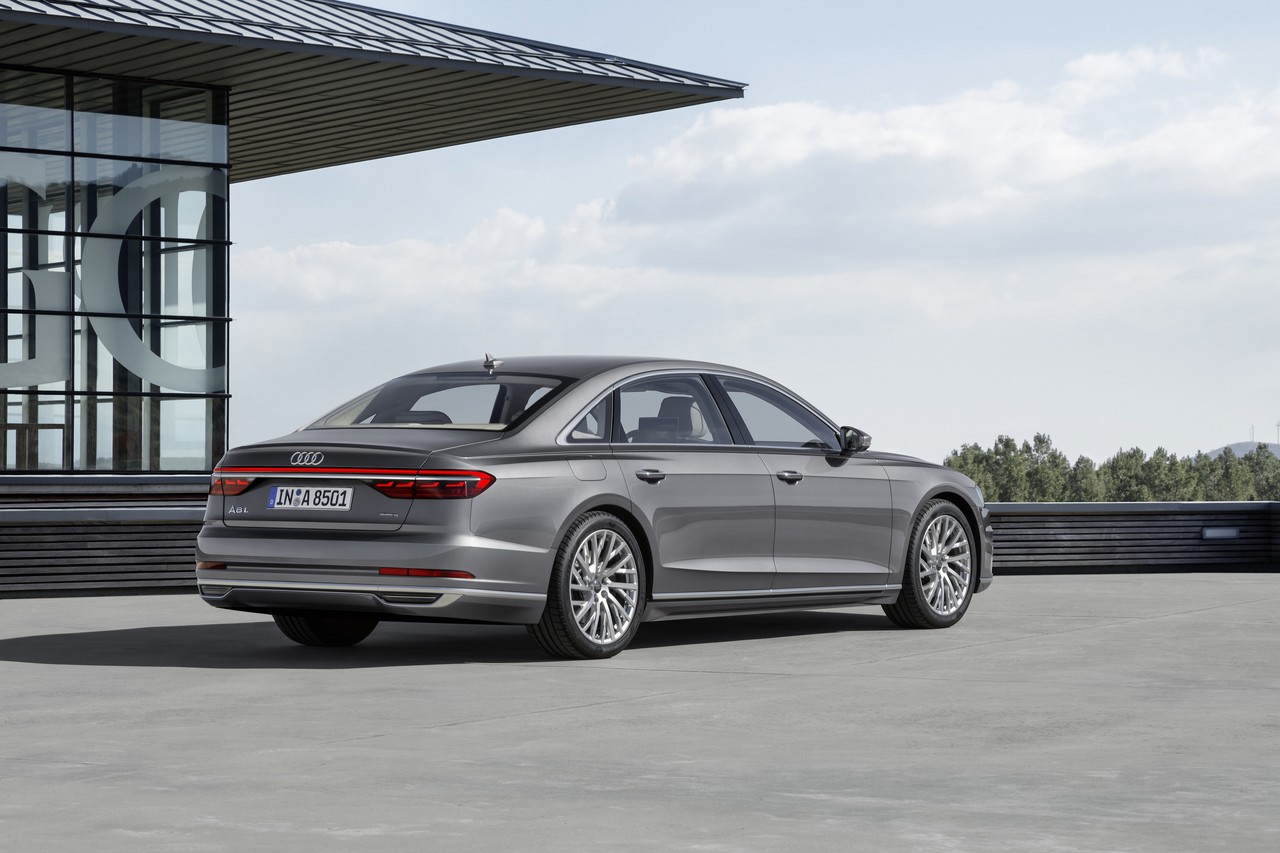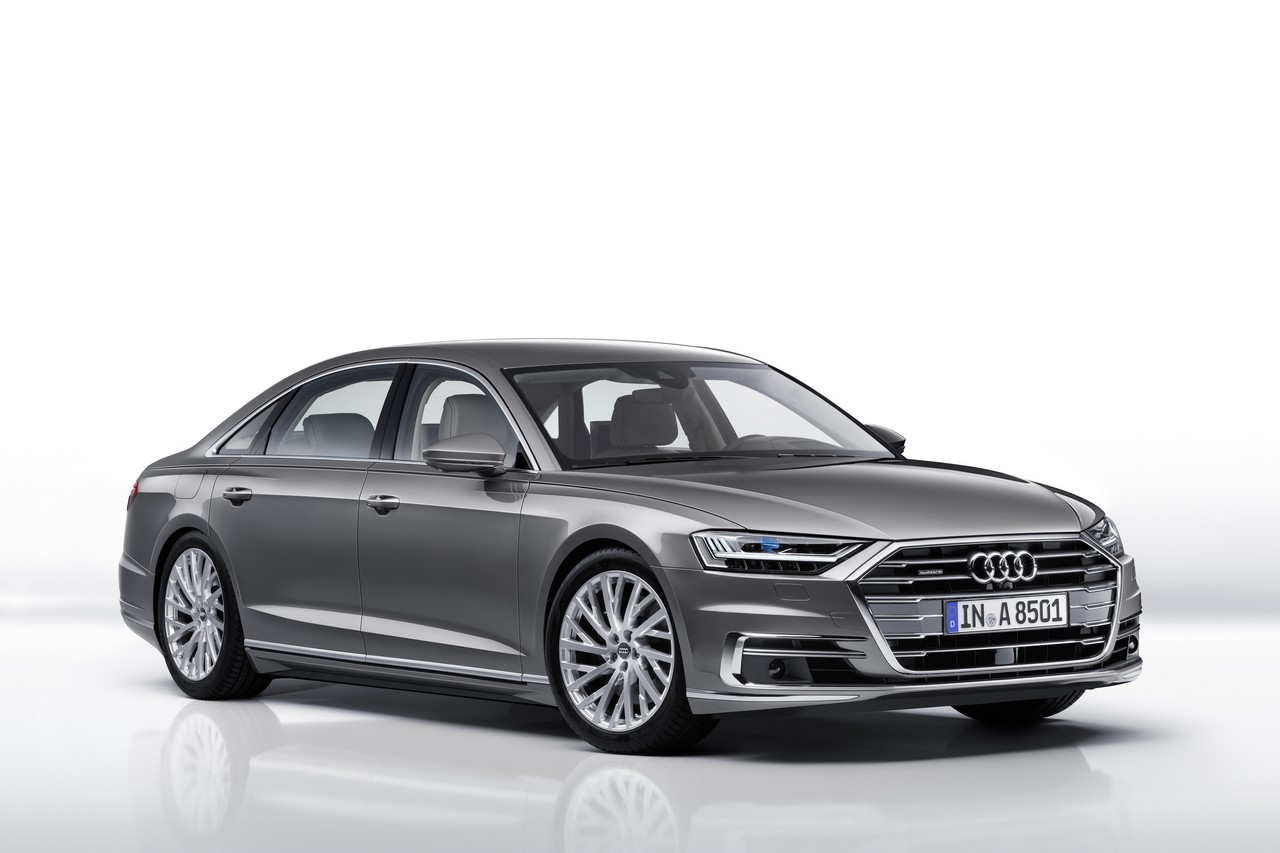
- Fuel-saving mild hybrid technology fitted as standard across the range
- Frugal turbo-diesel engines bring grunt
- High standard of interior fit and finish
- quattro system provides excellent traction
- Bland styling
- Steering feel?
Overview
Commencing production in July 2017, the Audi D5 A8 and A8 L are prestige sedans with standard and long wheelbases, respectively. Manufactured in Neckarsulm, Germany, the all-wheel drive Audi D5 A8 range consists of 3.0 TDI, 3.0 TFSI, 4.0 TDI, 4.0 TFSI CoD, 6.0 W12 CoD and 3.0 TFSI e-tron variants. The Audi D5 A8 is expected to be released in Australia in mid-2018 in 3.0 TDI and 4.0 TDI variants.
Mild hybrid technology
All variants within the Audi A8 range have mild hybrid technology which can shut down the engine when the vehicle is coasting. The mild hybrid technology is based on the Audi A8’s 48 volt electrical system which is powered by a belt alternator starter (BAS) connected to the engine’s crankshaft by the belt drive. Furthermore, a lithium-ion battery is positioned beneath the luggage compartment floor to power electrical systems while the engine is shut down. Specifically, the mild hybrid technology provides:
- Engine shutdown when coasting at speeds from 55 km/h to 160 km/h without the engine running for up to 40 seconds. When the driver presses the accelerator pedal, the belt alternator starter restarts the engine;
- Start/stop operation which is generally active from 22 km/h; and,
- When the brakes are applied, the braking system can recover up to 12 kW of power.
| Variant | Engine | Trans. | Peak power | Peak torque |
|---|---|---|---|---|
| 3.0 TDI | 3.0-litre turbo diesel V6 | 8sp auto | 210 kW | 600 Nm at 1250-3250 rpm |
| 3.0 TFSI | 3.0-litre turbo petrol V6 | 8sp auto | 250 kW | 500 Nm at 1370-4500 rpm |
| 4.0 TDI | 4.0-litre turbo diesel V8 | 8sp auto | 320 kW | N/A |
| 4.0 TFSI CoD | 4.0-litre biturbo petrol V8 | 8sp auto | 338 kW | N/A |
| 6.0 W12 CoD | 6.0-litre biturbo petrol W12 | 8sp auto | 430 kW | 800 Nm at 1300-5000 rpm |
| 3.0 TFSI e-tron (A8 L only) |
3.0-litre turbo petrol V6 and electric motor | 8sp auto | 330 kW (combined) |
700 Nm (combined) |
quattro
Fitted as standard, the four-wheel drive ‘quattro’ system for the Audi D5 A8 is a purely mechanical system which utilises a self-locking central differential (designed as a planetary gear train). In normal conditions, the differential provides 60 per cent of the engine’s torque to the rear axle and 40 per cent to the front, i.e. a 40:60 front:rear torque split. Depending on the situation, however, up to 70 per cent of the engine’s torque can be transferred to the front and up to 85 per cent to the rear. The Audi A8 also has a wheel selective torque control function which can brakes the two inside wheels when cornering to prevent them from spinning.
As an option, the Audi D5 A8 can be specified with a sport differential which actively distributes drive torque between the rear wheels.
Eight-speed tiptronic
Across the range, the Audi A8 is fitted with an eight-speed ZF automatic transmission (Audi’s ‘tiptronic’). To reduce driveline vibrations, the transmission has an rpm-adaptive torsion damper (RTD) with a centrifugal force pendulum. Furthermore,
- The transmission is equipped with an electric oil pump which is activated when the Audi A8 is coasting; and,
- The transmission control in the Audi A8 can recognise ‘stop & go’ situations and modify the driving strategy accordingly (i.e. avoid unnecessary gearshifts or starting in second gear).
Body and dimensions
The Audi D5 A8 had five link front suspension with two transverse links on
- Hot-stamped steel is used for the cabin;
- 58 per cent of components – such as cast nodes, extruded sections and panels – are made from aluminium;
- The rear panel is produced from carbon fibre reinforced polymer (CFRP) in which fabric layers run in different directions with up to 19 of them criss-crossing; and,
- To reduce mass, the tower bar between the front suspension turrets is produced from magnesium.
According to Audi, the body of the 2018 Audi A8 achieves a 24 per cent increase in torsional rigidity.
Compared to the Audi D4 A8 , the 2018 Audi A8 is 37 mm longer (at 5172 mm), 5 mm narrower (1945 mm), 6 mm taller (1473 mm) and has a 6 mm longer wheelbase (2998 mm). For the Audi A8 L, the wheelbase is extended by 30 mm to 3128 mm relative to the A8, overall length increases by 130 mm (to 5302 mm) and the roofline is 12 mm higher (1485 mm). According to Audi, the D5 A8 premieres a new Audi design language which is characterised by its ‘fluidly muscular’ body.
Suspension: five-link design and ‘Audi AI’ active suspension
The Audi D5 A8 has five-link suspension front and rear, both of which are mounted on sub-frames. As standard, the Audi D5 A8 has adaptive air spring suspension – which enables the driver to select from four ride height levels – and hydraulically controlled dampers. At speeds above 120 km/h, the Audi A8’s body is automatically lowered by 20 mm for improved aerodynamics (provided the vehicle has been in its ‘auto’ or ‘dynamic’ modes for at least 30 seconds).
The Audi D5 A8 is available with ‘Audi AI active suspension’, an active electromechanically-operated suspension system. For each wheel, there is:
- One electrical motor powered by the 48 volt primary electrical system;
- A transmission;
- A rotary tube housing a titanium roll bar; and,
- A lever that exerts up to 1100 Nm on the suspension via a coupling rod.
With active suspension, load can be increased or reduced on each wheels for active control of the body in every driving situation. In its dynamic mode, Audi claims that roll angles are roughly halved compared with the standard mode.
In combination with ‘pre sense 360°’, the active suspension can raise the ride height of the vehicle by up to 80 mm (within half a second) if the vehicle is travelling at more than 25 km/h and an impending lateral collision is detected. By raising the body, a greater portion of the impact forces are absorbed by the side sills and floor structure such that impact forces on the occupants can be reduced by up to 50 per cent.
Steering
The Audi D5 A8 has rack-and-pinion steering with a speed-sensitive ratio (that varies from 9.5:1 to 17:1) and electric power assistance.
As an option, the Audi D5 A8 is available with ‘dynamic all-wheel steering’ which uses a spindle drive and two track rods to turn the rear wheels. At low speeds, the rear wheels can turn by up to five degrees in the opposite direction to the front wheels for greater manoeuvrability and to reduce the turning circle by around 1 metre (to 11.4 metres for the Audi A8 and 11.8 metres for the Audi A8 L). At medium and high speeds, however, the rear wheels turn by up to two degrees in the same direction as the front wheels for greater stability.
Safety equipment
Standard safety equipment for the Audi D5 A8 is expected to include dual front airbags, front and rear seat-mounted airbags, full-length curtain airbags (i.e. for front and rear occupants), ABS, electronic brake force distribution, brake assist, electronic stability control, traction control and front seatbelts with pre-tensioners and load limiters.
For its active safety technologies, the Audi D5 A8 is fitted with the following sensors:
- Twelve ultrasonic sensors on the front, sides and rear;
- Four 360 degree cameras on the front, rear and door mirrors;
- One front camera at the top edge of the windscreen;
- Four mid-range radars at the vehicle’s corners;
- A long-range radar on the front;
- A infra-red camera (night vision assist) on the front; and,
- A laser scanner mounted in the front bumper. The laser scanner emits light pulses on several vertical planes which are distributed by a mirror over a field about 80 metres deep and through a range of 145 degrees. Since the wavelengths of the pulses are in the near infra-red range, they are not visible to the human eye. The pulses are reflected by objects in front of the car detected by photodiodes in the laser scanner and interpreted for a contoured image of the surroundings.
For the Audi D5 A8, a central driver assistance controller (zFAS) forms a comprehensive image of the surroundings from the sensor data. The zFAS controller is approximately the size of a tablet computer and integrates high-performance computers from NVIDIA (Tegra K1), ALTERA (Cyclon V), Infineon (Aurix) and the EyeQ3 image processor from Mobileye.
In Europe, the Audi D5 A8 is offered with three Assistance Packages: City, Tour and Park. The City Assistance Package includes –
- Crossing assist: if the mid-range radars detect critical crossing traffic in front of the car, the system warns the driver and makes a brake application if required;
- Exit warning system: indicates vehicles or cyclists approaching from the rear when opening the door and light guides indicate the danger optically;
- Cross traffic assist rear: when reversing at low speeds, rear cross-traffic assist uses the rear radar sensors to detect approaching traffic. If approaching traffic is detected which may cross the vehicle’s path, the driver receives warnings (visual, acoustic and a brief, jolting application of the brakes); and,
- The pre sense 360 degree safety system: detects collision hazards all around the vehicle and initiates preventive measures such as full brake application, adjusting the seats or tightening the belts. Also, Audi AI active suspension can raise the body by up to 80 mm.
The Tour Assistance Package includes –
- Pre sense front: operates at speeds up to 250 km/h and can prevent front-to-rear collisions or reduce their severity. In hazardous situations, the driver receives visual and acoustic warnings to apply the brakes, followed by a brief application of the brakes for a jolting effect to alert the driver. If the driver fails to respond, the A8 decelerates to the greatest possible extent if the vehicle ahead of it is still moving;
- Adaptive Driving Assistant (ADA): includes adaptive cruise control (ACC), lane assist function and traffic jam assist. These functions operate from rest up to 250 km/h;
- Bottle neck assist: guides the A8 through construction sites and similar zones;
- Turn assist: monitors the lane of oncoming traffic when the driver is turning across it and when oncoming vehicles are turning in front of the Audi A8. Turn assist includes individual wheel braking and steering assistance functions;
- Collision avoidance assist: activated when the A8 needs to avoid an obstacle to avert a collision. Using data from the front camera, the ACC and radar sensors, ‘avoidance assist’ can calculate the distance of the car ahead, its width and degree of offset. The brakes are briefly applied to alert the driver of the potential danger and, once the driver starts steering, the system provides ‘support with the necessary lane changes with controlled interventions to the power steering’;
- Traffic sign recognition; and,
- Emergency assist: brings the vehicle to rest if the driver is not able to do so.
As a stand-alone option, the D5 A8 is also available with ‘night vision assist’ which uses an infra-red camera to detect pedestrians and larger animals at long distances and warns the driver of their presence.
Audi AI traffic jam pilot
The Audi D5 A8 introduces ‘Level 3’ automated driving technologies, In contrast to ‘Level 2’, the driver does not need to continually monitor the vehicle and instead only needs to re-assume responsibility when prompted. However, Level 3 autonomous driving technologies do not currently have legal approval and will therefore not be offered at the vehicle’s launch. According to Audi, however, these technologies will be introduced into production in 2018 and offered in markets where they have legislative approval.
Audi’s ‘traffic jam pilot’ provides autonomous driving at speeds up to 60 km/h on freeways and highways where a physical barrier separates the two carriageways. Activated using the ‘AI’ button on the centre console, the traffic jam pilot provides starting, accelerating, steering and braking functions, such that the driver can remove their hands from the steering wheel. During piloted driving, a central driver assistance controller (zFAS) computes an image of the surroundings by merging sensor data (from radar sensors, a front camera, ultrasonic sensors and, in a first for a car manufacturer, a laser scanner). When the limits of traffic jam pilot are reached, the driver is alerted to take back control of driving. If vehicle speed exceeds 60 km/h and the driver does not assume control, then the vehicle is braked to a standstill.
Interior features
Inside, the D5 A8 features Audi’s Modular Infotainment Platform (MIB 2+) which includes a K1 NVIDIA unit with a quad-core main processor and a 192-core graphics processor. The instrument panel features a 10.1-inch touchscreen (‘MMI touch response’) with a resolution of 1540 x 720 pixels. With MMI touch response, the driver needs to press the touchscreen with a defined pressure and, when applied, feels ‘a gentle pulse generated by an electromagnet moving the display glass minimally sideways’; a small speaker also emits a click sound.
The Audi A8 features a second display with a screen diagonal of 8.6-inches and a resolution of 1280 x 660 pixels on the centre tunnel console which the driver can use to control air conditioning and comfort features. The driver can also enter text – via a keyboard or handwriting recognition – on this display for navigation destinations or search term. Beyond this, the ‘Audi virtual cockpit’ consists of a 12.3-inch TFT monitor – in place of a conventional analogue instrument dials – which has an HD resolution of 1920 x 720 pixels.
As an option, the Audi A8 will be available with a head-up display that projects information onto the windscreen so that it appears in the driver’s field of vision. Projected information includes vehicle speed, navigation messages and information from assistance systems.
For the Audi A8 L, an optional rear ‘relaxation seat’ has four different adjustment options, and can be reclined so that its occupant can rest their feet on an electrically folding surface on the backrest of the front seat for foot warming and massage functions.
AI remote parking pilot
The Audi D5 A8 is available with the ‘Audi AI remote parking pilot’ and ‘Audi AI remote garage pilot’ which provide autonomous steering for parking manoeuvres, and can be performed without the driver sitting in the car. To monitor the parking manoeuvre, the driver holds the Audi AI button to watch a live display from the car’s 360 degree camera on their synchronised device.
HD Matrix LED headlights with laser lighting
The Audi D5 A8 is available with HD Matrix LED headlights which feature laser lighting. Specifically, Each HD Matrix LED headlight incorporates 138 LEDs (grouped into 32 units) and one high-performance laser diode which is activated at speeds above 70 km/h and doubles the range of the high beam. Using data from the front camera, the LED units can be turned off to avoid dazzling other drivers. Furthermore, cornering light is produced by displacing the light’s focal point and uses navigation data to illuminate into a bend before the steering wheel is turned. Similarly, the junction light can illuminate predictively before a junction is reached.
